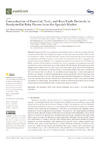Identificador persistente para citar o vincular este elemento:
https://accedacris.ulpgc.es/jspui/handle/10553/124209
| Título: | Concentration of Essential, Toxic, and Rare Earth Elements in Ready-to-Eat Baby Purees from the Spanish Market | Autores/as: | Henríquez Hernández, Luis Alberto Acosta Dacal, Andrea Carolina Domínguez Boada, Luis María Zumbado Peña, Manuel Luis Serra Majem, Luis Pérez Luzardo, Octavio Luis |
Clasificación UNESCO: | 32 Ciencias médicas 3206 Ciencias de la nutrición 320611 Toxicidad de los alimentos 320110 Pediatría |
Palabras clave: | Baby Food Chemical Elements Food Safety Heavy Metals Rare Earth Elements, et al. |
Fecha de publicación: | 2023 | Publicación seriada: | Nutrients | Resumen: | Background: The infant population is particularly sensitive, so the risk posed by their diet must be analyzed. The aims of the present study were (i) to determine the contents of 38 elements in 159 samples of ready-to-eat baby food sold in Spain and (ii) to estimate the dietary intakes and risk assessments of these elements in name brands and store brands in infants ranging between 6 and 12 months of age. Methods: A list of essential, non-essential/toxic elements, rare earth elements (REEs), and other hi-tech-related elements that are currently considered as emerging environmental pollutants were measured in ready-to-eat baby foods by ICP-MS. Results: Fish purees showed the highest concentrations of mercury (28.1 ng/g) and arsenic (346.2 ng/g). The levels of manganese, molybdenum, and chromium exceed the adequate intake, being higher in the case of store brands. The acute hazard index was above 1 for molybdenum and manganese. A risky consumption of thallium and mercury was observed, being higher among name brands. The risk associated with the consumption of REEs was low, although its presence should be highlighted. Conclusions: This is the first time that these chemical elements have been measured in ready-to-eat purees for babies. The presence of some of them, such as mercury, should be sufficient to monitor the levels of these contaminants in food intended for such a sensitive population as children. | URI: | https://accedacris.ulpgc.es/handle/10553/124209 | DOI: | 10.3390/nu15143251 | Fuente: | Nutrients[EISSN 2072-6643],v. 15 (14):3251, (Julio 2023) |
| Colección: | Artículos |
Citas SCOPUSTM
6
actualizado el 08-jun-2025
Citas de WEB OF SCIENCETM
Citations
7
actualizado el 12-ene-2026
Visitas
4
actualizado el 10-ene-2026
Descargas
1
actualizado el 10-ene-2026
Google ScholarTM
Verifica
Altmetric
Comparte
Exporta metadatos
Los elementos en ULPGC accedaCRIS están protegidos por derechos de autor con todos los derechos reservados, a menos que se indique lo contrario.
